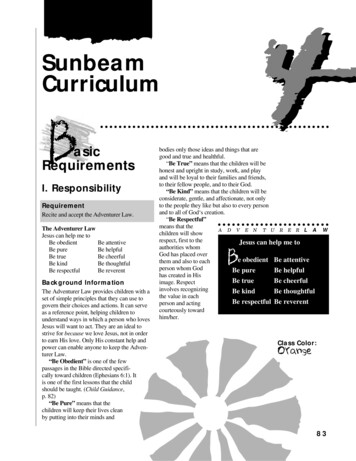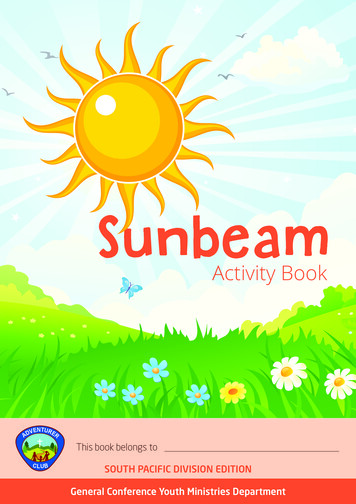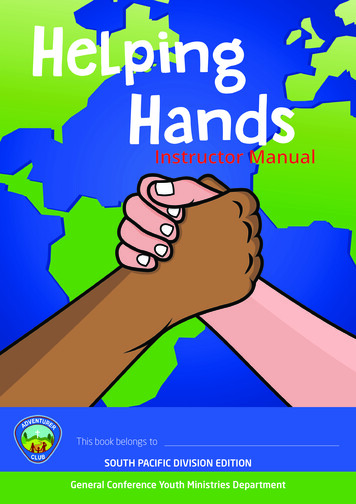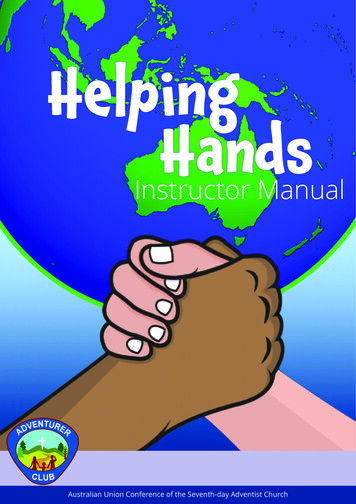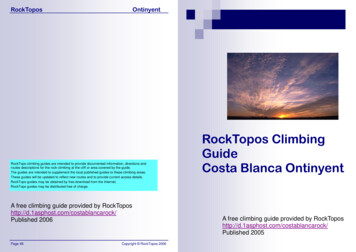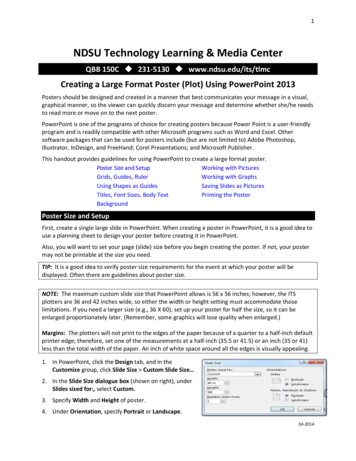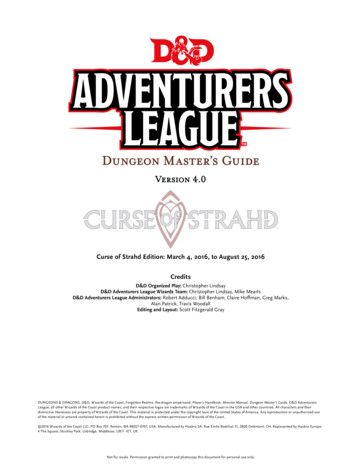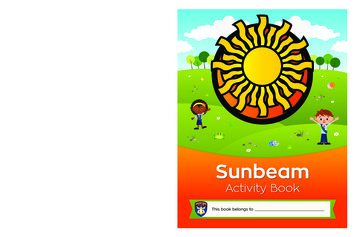
Transcription
SunbeamActivity BookThis book belongs to
Note to Instructorsand Parent(s)/Guardian(s)This activity book is designed as an ancillary resource to the Sunbeamcurriculum. It is important that Adventurers learn through all their senses,so singing, smelling, listening, and activities that require movementshould be of primary importance in your program.Activity booklets may be used in whole, or the pages may be removedand completed one at a time. Collecting the completed pages and bindingthem together (with a stapler, yarn, or in a binder) at the end of the yearwill provide a keepsake for the children to remind them oftheir year as a Sunbeam.In the back of this booklet you will find teaching helps foreach activity (look for the icon to the right) and a checklistof investiture requirements for the Sunbeam level.TeachinTIPSpagge 29Distributed by:AdventSource5120 Prescott AvenueLincoln, NE 68506adventsource.org402.486.8800Copyright 1994, 1996, 2015 North American Division Corporation ofSeventh-day Adventists. 3rd printing.Permission to make photocopies or to reproduce by any other mechanicalor electronic means in whole or in part and designed page, illustrationor activity in the book is granted only to the original purchaser and isintended for non-commercial use within a church, school, or club. Noneof the materials in this book may be reproduced for any commercialpromotion, advertising, or sale of a product or service. Sharing of thematerial in this book with other churches, schools, or organizations isprohibited. All rights reserved.Editor: Teresa ReeveCover designer: Aphelandra MesserPage designer: Glen Milam for Wesley Thor StudiosIllustrator: Orchard Hill CommunicationsProject manager: Christal GregersonPrinted in the U.S.A.ISBN# 978-1-62909-201-0
Basic IAdventurer LawRecite and accept the Adventurer Law.Adventurer LawJesus can help me to:Be obedientBe pureBe trueBe kindBe respectfulBe attentiveBe helpfulBe cheerfulBe thoughtfulBe reverent1
Fill in the blanks and discover how much Jesus loves you.loves very much and(my name)wants me, , to be happy. That’s(my name)why He came as acan be aandfor me. Nowand help other people be(my name)too.Using the pictures on the next two pages, make an Adventurer Law Booklet.1. Cut on the black lines.2. Fold on the dotted lines.3. Put the pages together.4. Staple on the dotted lines.2
1Be obedientBe reverent103Be trueBe cheerful85Be respectfulBe attentive63
MyAdventurerLawJesus can help me to . . .49Be thoughtfulBe pure27Be helpfulBe kind4
Basic IIReading AwardTeachinTIPSpagge 29Complete the Sunbeam Reading award.Read or listen to the book being read. Then color the picture.Two (2) chaptersfrom MarkBook onfamily, friends,or feelingsBible story book ora book about JesusBook on history ormissionsBook on health or safetyBook on nature5
My God IGod’s Plan to Save MeTeachinTIPSpagge 29A. Create a story chart or lapbook showing Jesus’:yy Birthyy Lifeyy Deathyy ResurrectionORthe Bible stories you are studying in school or Sabbath School.B. Use your story chart or lapbook to show someone the joy of being savedby Jesus.I showed !S T E P B Y S T E PSunbeam Bible Story nenavHeesomsCsurJe ainfoAgesarsC ysu daJe ToMeintSirseFThntioeaCr6Jesus’Life
Jesus’ BirthJesus, God’s Son, came to earthas a baby to help people.7
Jesus’ LifeJesus showed people how much Heloves them. He showed how happywe can be if we obey Him.8
Jesus’ DeathJesus let evil men kill Him on a crossbecause He wanted to take away our sins.9
Jesus’ ResurrectionJesus came back to life after three days.He is in heaven now, watching over us.10
My God IIGod’s Message to MeTeachinTIPSpagge 30A. Memorize and explain two Bible verses about being saved by Jesus.Match the texts with what they say.yy Matthew 22:37-39Jesus will forgive and help me if I’m sorry formy sins.yy I John 1:9To love God and other people is important.yy Isaiah 1:18God wants me to live forever.yy Romans 6:23Jesus wants to make me clean inside.yy Your choice11
B. Name the two major parts of the Bible.O-TNT.and the four gospels.121. M3. L2. M4. J
My God IIIGod’s Power in My LifeTeachinTIPSpagge 30A. Spend regular quiet time with Jesus to talk with Him and learn about Him.Color a square each time you finish a quiet time (or use stickers to fill yoursquares).Things to do:With whom?When?Where?13
B. Ask three people why they study the Bible.I’ll askuse:ible becaBehtytudPeople s14
My Self II Am SpecialTeachinTIPSpagge 30Make a tracing of yourself. Decorate it with pictures and words which tellgood things about yourself.You could write or draw about things you like, things your are good at, thingsyou wish, and things about your family and friends.15
My Self III Can MakeWise ChoicesTeachinTpaIPSgge 31Participate in an activity about choices.Use words or pictures to show what you would choose.If I ,I would.16
My Self IIII Can Carefor My BodyTeachinTIPSpagge 32Fitness Fun Award 1. Read and discuss Jeremiah 29:11. 2. List at least four things that contributeto physical fitness. 3. Do three different stretches. Hold each for aminimum of 15 seconds.a. Legb. Backc. Arms and shoulders 4. Do four of the following:a. Run, jog, or walk one-half mileb. Skipc. Jump rope for three minutesd. Jumping jacks—do at least 15e. Hop on one leg at least five times—see howmany you can dof. Sit-upsg. Exercise of your choice17
18 5. Participate in two of the following:a. Obstacle courseb. Leap frogc. Relay race 6. Participate in an organized game that requiresphysical exercise.
My Family II Have a FamilyCreate a family collage, scrapbook, crest, orcoat of arms.TeachinTIPSpagge 3219
My Family IIFamily MembersCare for Each OtherTeachinTIPSpagge 32A. Show how Jesus can help you deal with disagreements. Use puppets, roleplaying, or your choice.Report on what you did:20When I feelunhappy withsomeone, I will . . .1. Think about what theproblem is.2. Talk about it privatelywith the person. Listen.3. Look for solutionstogether.4. Ask for help, if I needto.
My Family IIIMy Family HelpsMe Care for MyselfRoad Safety Award 1. Identify and explain 10 important roadsigns.RRYIELD21
22 2. Tell when and where to cross the road safely. 3. Give road safety rules for:a. Walking along the road by yourselfb. Riding your bicyclec. Riding a horsed. Walking with a group 4. Explain why you should wear a seat belt whenriding in a car. 5. Listen to a highway patrol officer or other safetyofficer talk about safety for children. 6. Play a safety game.
My World IThe World of FriendsCourtesy Award 1. Explain what “courtesy” means. 2. Recite and explain the Golden Rule. 3. Be able to demonstrate good table manners:a. Properly set the tableb. Correctly ask for and pass foodc. Properly excuse yourself from the table 4. Make a telephone call using good telephonemanners:a. To an adultb. To a friend of your choicec. Be able to answer the phone correctlyOR introduce:d. An adult to a friende. Your teacher to a parent/guardian23
5. Share an experience:a. When an adult was courteous to youb. When you were courteous to another person 6. Show acts of courtesy as you:a. Ask for a drinkb. Say thank youc. Apologized. Greet a friende. Share and take turns (not shown)Fill in the balloon with a courteous statement.24
My World IIThe World ofOther PeopleTeachinTIPSpagge 33A. Explore your neighborhood. List things that are good and things you couldhelp make better.Good thingsThings I can help make better25
B. From your list, choose ways and spend time making your neighborhood better.Share what you did.I26
My World IIIThe World of NatureFriend of Nature Award 1. Take a nature walk and discover itemsof interest.a. Show or tell what you found.b. Make these items into a collage or poster. 2. List the names of three different trees and do abark rubbing of each. 3. Collect four different kinds of leaves and compare.27
28 4. Go on a critter hunt. Explore (or observe with amagnifying glass) all the things you can see in a 10sq ft area.ORExplore a yard or park and talk about what you see. 5. Visit one of the following:a. Zoob. Parkc. Wildlife area 6. Explain how to become a friend of nature such ashow to protect trees, nests, etc.
gTeachinTIPSSuggestions forParents or LeadersBasicPage 5 The Sunbeam Reading award is given to childrenwho read or listen while someone else reads:1. Two chapters from the Gospel of Mark, from asimple, modern translation of the Bible2. A Bible story book or a book about Jesus3. A book on health or safety4. A book on family, friends, or feelings5. A book on history or missions6. A book on natureProvide children with several good books tochoose from which will help them to understandand apply the things they are learning this year inthe Sunbeam level.Be sure that the books are:1. True to life. The books must present anaccurate picture of reality. It must not beoverly simplistic, sentimental, or exciting.2. Lasting value. A good book helps the child tounderstand God, human nature, or the thingsof creation without appearing to be preachyand contrived.3. Morally positive. Evil and sin are recognized assuch, and receive their just reward. The goodshould be upheld as the model and goal forthe children.4. Enjoyable. The book should be one that theadult enjoys reading. (If the adult does notenjoy it, it is highly unlikely that the childwill—or should.)5. Developmentally appropriate. A good bookwill fit the child’s level of reading ability,sophistication, and interest.My God: God’s Plan to Save MePage 6The Sunbeam requirement builds upon the BusyBee emphasis on Jesus’ love and care for us andHis plan to save us from evil.The primary focus of these stories is to help thechildren see the gift of God in Jesus—His birth,life, death, and glorious resurrection. When wehear stories of Jesus’ love and care, we are drawnto Him. We can trust Him with our problems andcares.As the children learn of Jesus and hear us talkabout “giving our hearts to Jesus” they will wantto know how this is done. Not all will be ready orwilling to commit their lives at this time, but theycan be given the opportunity to understand whatit means to belong to Christ.Do not pressure children to make a decisionbefore they are ready. You may wish to follow thisprocedure:1. Pray yourself for the Holy Spirit’s leading.2. Take the children through the Steps to Jesus.3. Ask the children if they would like to make adecision to give their lives to Jesus. Help thempray their own prayer, telling God that theyadmit their need, ask forgiveness, state theirbelief, and ask Jesus into their life.4. Many children will find it easier to take thisstep if they have previously made private,inner decisions. They now follow up bymaking their decision public—by telling aparent, a leader, and their pastor. They maystart planning to join a baptismal class. (Butavoid hurrying a decision without adequatepreparation.)29
Steps to Jesus1. Recognize GOD’S LOVE for them. (I John 4:8)2. Admit THEIR NEED. All have sinned anddeserve the consequences. (Romans 3:23;Revelation 21:27; John 8: 21, 24)3. Jesus is the WAY. The sinless Son of God diedfor our sins. He is the only way to heaven.(John 3:16; I Corinthians 15: 3,4)4. Help them RECEIVE JESUS. They admit theirneed and ask forgiveness.5. They state their belief in Jesus and ask Himinto their lives. (John 1 :12; Revelation 3:20)6. Give them ASSURANCE that they are God’schildren and have a place in heaven. (John 3:36; John 3:16; 1:2)The Bible Story Chart may be used in threedifferent ways:1. Place the pictures on a large wall story chart,adding each new picture as you tell the story.The children may refer to this chart as theywork on their own chart(s) and as they learnabout other stories from the Bible and history.2. Provide the children with a practice activityby making available a blank chart and thepictures, stories, and labels provided on thefollowing pages. The children may set theblank chart on the floor and place the pictures,stories, and labels in order on the chart.3. Children may also color the pictures and usethe stories and labels to create their own storycharts or lapbooks.ReviewReview the major events of earth’s historyintroduced at the Busy Bee level: creation, thefirst sin, Jesus cares for me today, Jesus comesagain, and heaven.My God: God’s Message to MePage 11Help the children memorize and explain twoBible verses about being saved byJesus. The information on page 11 will assist thechildren with their explanations.Answers:A.Matthew 22:37-39—To love God and other peopleis important.301 John 1:9—Jesus will forgive and help me if I’msorry for my sins.Isaiah 1:18—Jesus wants to make me cleaninside.Romans 6:23—God wants me to live forever.B.Old TestamentNew TestamentC.1. Matthew2. Mark3. Luke4. JohnMy God: God’s Power in My LifePage 13Your child needs your example and leadership ashe tries to form good devotional habits.You can help by: Having your own daily quiet time with Jesusdaily Enthusiastically sharing some of theinspiration and insights you receive duringyour quiet time Leading out in family worship daily Helping your child choose a wise time andplace for his/her quiet time Being a part of your child’s quiet time until he/she is able and eager to continue on their ownMy Self: I Am SpecialPage 15The tracings can be made in two ways:1. If there is sufficient paper and space, haveeach child lie on a large sheet of butcher paperwhile another child traces around his/her bodywith a watercolor marking pen.2. Tracings may also be done by using a stronglight to project a profile of each child onto apiece of paper that has been taped to the wall.Another child can trace around the shadowwith a pencil.Next, have each child describe himself/herselfusing some of the following ideas. This maybe done together at the teacher’s direction, or
various ideas may be written on cards for thechildren to work with individually. Drawings,cutout pictures, or written words and phrasesmay be used.1. Child’s name, its meaning, how parentschose it2. Physical Characteristicseye/hair colorlength of foot, hand, armfingerprint, footprintclothingageheightweightbirthday (earliest memory )home addressphone numberheart rate (sitting, running)3. Likes and Dislikesfoodcoloranimalthings to do (alone, with friends or family)game or sportbooktree or flowermonth or daynumberweatherholidayheroBible versepeopleBible characterplacesongsubjectthings to make4. FeelingsI feel xcitedrejectedafraidimportant5. Special Abilitiesbest/nicest thing I ever didthings I’m good atI feel good about me because 6. Ideas and Dreamsday dreamsthree wisheswhen I grow up I will be I believe in someday I hope something I want to change about myself is in 5-25 years I want to Emphasize the importance of “internal”characteristics by first putting only physicalthings on the tracings. Ask whether the childrencan tell, from those things, whether a personwould make a good friend or neighbor. (See 1Samuel 16:7.)Display the tracings for children to discuss andenjoy. A picture of Christ and a heading such as“Jesus Made Us Special” may be hung above them.Take time to discuss similarities and differenceswith the children to help them learn to acceptand appreciate each other for their uniqueness.Discuss any prejudices or stereotypes the childrenmight face, and help them deal with them.My Self: I Can Make Wise ChoicesPage 16The choices we make daily are based upon thosethings that we consider to be truly valuable.These values strongly influence our feelingsand thoughts. They influence our decisionseven though we may be unaware of it. Oftenpeople claim to value something very highlybut their actions show that there is a differencebetween what they claim to value and whatthey actually value. One example would bethe mother who tells her child that honesty is apriority but who keeps extra change accidentallygiven her by a grocery store clerk. A drasticexample of this problem is provided by thebiblical Pharisees. They claimed to love God atthe same time they were crucifying Him.Examining the things we value is one of the firststeps in wise decision-making. When faced witha decision, second-grade children can learn to sayto themselves. “What is most important to me?”This activity enables children to practice decisionmaking based upon their decisions to committheir lives to Jesus.31
Activity About Choices1. One option is to have the children play the“What If?” game. Some problems which thechildren might consider include: What if you had 50; how would you spend it? What if you had only one week to live; whatwould you do with it? What if you could choose only three peoplein all the world; which three would youchoose as friends?The children or leader may suggest otherproblems. The leader may read a story to thechildren, stopping at the point where the problemis introduced to discuss solutions.2. Go over one of the problems listed above withthe children, modeling how they can make awise decision. Encourage them to ask: What does the Bible say about this? Is this just fun for now or will it help melive happily forever? Is this really important to me?3. Allow children to work as pairs or individualson the problem of their choice. As theypresent their solution to the group, theyshould use the questions above to explainwhy they think their solution is a good one.Allow for group discussion of each solution.There is no one right answer.My Self: I Can Care for My BodyPage 17Make this award fun by: Building food group collages or sorting types offood into boxes Enjoying an exercise activity together in thesunshine and fresh air Having a healthy water-drinking contestMy Family: I Have a FamilyPage 19Every family has enjoyed experiences that wereextra-special. These may be times that wereparticularly enjoyable or meaningful or thathelped them to feel close to each other. Oftenfamilies have not considered which of theiractivities may be important to other familymembers. Many family members may haveexperiences which they treasure but that othermembers have not recognized as special.Be sensitive to children from different types offamilies. Emphasize that there are various kindsof families.Do this activity as a:1. Family worship2. Adventurer Club Family Night3. Individual project4. Supper table discussionMy Family: Family MembersCare for Each OtherPage 20One of the first things that should be understoodabout disagreement is that disagreement isokay and normal. A disagreement does notindicate that anyone is bad, wrong, or stupid.Disagreements can be very positive because theyallow people to bring problems and feelings intothe open so they can be solved.Use this outline to help children understand whatto do when they feel unhappy with someone.1. Think about it. Ask yourself: Why am Ifeeling this way? What is the disagreementabout? Why might the other person be actingthis way? Is it something I can ignore or solvemyself? Am I doing something to create theproblem?2. Talk about it privately. Listen. Choosea good time and place. Tell how you feel andspecifically why you feel that way. Listencarefully to the other person’s feelings and tryto understand why he/she is feeling that way.Never interrupt the other person when they aretalking.32
3. Look for solutions. Together think of waysto solve the problem. This might include doingwhat you or the other person wants, findinga compromise, thinking of other ideas, oragreeing to disagree. Choose one solution andact on it.4. Ask for help if you need it. Tell yourproblem to an adult you trust and ask him/herto help you find a solution.As each step is discussed, the children may usepuppets or role playing to show different ways inwhich they can carry out that step. It will be easierfor the children to visualize if they are given aspecific situation to deal with as they go throughthe steps; e.g., someone cuts in line at the drinkingfountain, or your brother borrowed your crayonswithout permission and broke them.The children’s knowledge of these steps will haveno meaning until they begin to practice the stepsthemselves. To do this:1. Refuse to hear children’s tattling orcomplaints about each other until they haveattempted to solve the problem themselves(except in emergency situations).2. If the child has not yet attempted to follow theproblem solving steps, remind him/her to doso and be sure they remember how.Children’s lists might include: communityservices, such as a fire or police station or grocerystore; a special landmark, such as a park, river, orspecial building; a particularly nicely kept homeor garden (not expensive, but orderly). Helpthe children to find as many of these things aspossible on their own so they can enjoy a sense ofexploration and discovery.The children can list a number of differentprojects to help the needs they have seen.Then lead them to decide upon an activityor project they can do well and feel a senseof accomplishment in completing. A fewpossibilities include: Beautification: Clean up a road, park, orvacant lot; plant flowers or trees. Visit shut-ins: Present programs fornursing homes or children’s wards; adopt agrandparent; do yard work; wash windows;read letters and cards; make phone calls; createMay baskets. Help those in need: Collect clothing orfood; raise funds for a special project; tutorfirst graders. Spiritual assistance: Form specialprayer bands; help with VBS, fair booth,neighborhood Bible club; literaturedistribution.3. Supervise the child’s attempts to follow thesteps, if necessary. Many times children cansolve the problem alone when reminded, butoccasionally (especially at first) they may needsome kind of supervision. The leader mayneed to ask the child to wait until a time whenhe/she can sit down with them, or he/she maysupervise the problem-solving discussion bystanding nearby and listening “with one ear”while supervising the rest of the group.My World: The World of Other PeoplePage 25To prepare children for this activity, review Jesus’special trip to our earth to help us, and point outsome of the many places in the Bible where Heasks us to help our neighbors.The children’s walking tour should be leisurelyand not more than an hour and should not try tocover a whole neighborhood but rather see someof the representative parts. Part of the tour maybe completed by car or bus.33
NameDate StartedDate CompletedSunbeam ChecklistBASICq I. Recite and accept the Adventurer Law.q II. Complete the Sunbeam Reading award.MY GODMY FAMILYq I.qq II. God’s Message to Meq A. Memorize and explain two Bible versesqabout being saved by Jesus:yy Matthew 22:37-39yy 1 John 1:9yy Isaiah 1:18yy Romans 6:23yy Your choiceB. Name the two major parts of the Bible andthe four gospels.Create a family collage, scrapbook, crest, orcoat of arms.q II. Family Members Care for Each OtherShow how Jesus can help you deal withdisagreements. Use:yy Puppetsyy Role playingyy Your choiceq I. God’s Plan to Save Meq A. Create a story chart or lapbook showingJesus’:yy Birthyy Lifeyy Deathyy ResurrectionOR the Bible stories you are studying inschool or Sabbath School.B. Use your chart or lapbook to showsomeone the joy of being saved by Jesus.I Have a Familyq III. My Family Helps Me Care for MyselfComplete the Road Safety award.MY WORLDq I.The World of FriendsComplete the Courtesy award.q II. The World of Other Peopleq A. Explore your neighbor-hood. List thingsqthat are good and things you could helpmake better.B. From your list, choose ways and spend timemaking your neighborhood better.q III. The World of NatureComplete the Friend of Nature award.q III. God’s Power In My Lifeq A. Spend regular quiet time with Jesus to talkwith Him and learn about Him.q B. Ask three people why they study the Bible.MY SELFq I.I Am SpecialMake a tracing of yourself. Decorate it withpictures and words which tell good thingsabout yourself.q II. I Can Make Wise ChoicesParticipate in an activity about choices.q III. I Can Care for My BodyComplete the Fitness Fun award.35
SunbeamActivity BookThis book belongs to
Page 5 The Sunbeam Reading award is given to children who read or listen while someone else reads: 1. Two chapters from the Gospel of Mark, from a simple, modern translation of the Bible 2. A Bible story book or a book about Jesus 3. A book on health or safety 4. A book on family, friends, or feelings 5. A book
